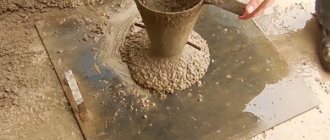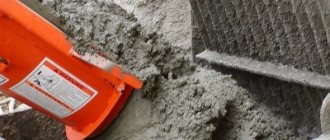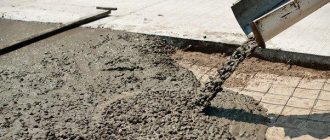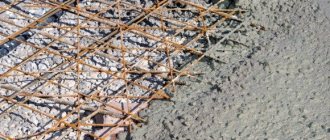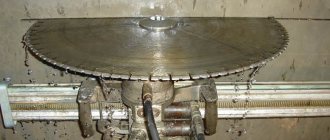Beton-House.com
Website about concrete: construction, characteristics, design. We combine the experience of professionals and private craftsmen in one place
Workability of concrete
The mobility of a concrete mixture is one of the most important indicators that determine its ability to spread and compact in the formwork under the influence of its own weight. To carry out construction work and ensure the required quality of concrete in structures, it is necessary that the mobility of the concrete mixture GOST 7473-2010 meets all the standards and requirements of this document.
What is the mobility of concrete, and what effect does it have on the workability of mixtures, we will consider in this article.
- Methods for determining the workability of concrete
- Mix consistency regulators
Workability of concrete mortar: what is it?
Concrete stone is a durable building material, a product of hydration reactions occurring in an aqueous cement solution. Additionally, filling components can be added to the composition:
- sand;
- crushed stone;
- gravel.
The amount of water in the concrete mortar may vary.
Important!
The water-cement ratio shows the amount of water in the concrete dough. The usual w/c value is usually 0.3-0.55. For the hydration reaction, a w/c of less than 0.3 is sufficient, but the mixture turns out to be very thick.
The workability of concrete depends on two parameters:
- mobility;
- delamination.
Mobility (workability) P4
produces plastic concrete with different mobility and delivers it to the construction site. If you want to buy concrete with mobility p4, you can contact us by phone from 8 a.m. to 8 p.m. (7 days a week). We have prepared information that reveals the parameters of concrete mobility, as well as the scope of application of concrete mixtures p4.
If we talk about the mobility of concrete, there are four grades. Each of them is intended for use in certain conditions. How do these brands differ from each other and what does P4 mobility mean? We need to figure it out.
Concrete p4
This term has several synonyms, so do not be alarmed when you encounter the following synonyms in various sources: workability, elasticity, plasticity.
The property characterizes the ability of the concrete mixture to be evenly distributed inside the formwork. Brands are divided into groups:
- hard mixtures;
- liquid mixtures.
The former can be produced without the use of plasticizers (cost reduction), they have good strength. The latter ensure faster pouring of a monolithic structure and a reduction in the labor intensity of the process. The choice between these brands depends on specific conditions.
The mobility of the P4 concrete mixture characterizes it as liquid. This means that P4 concrete, without additional support, holds its shape worse than P3 or P2. Naturally, this is only relevant for an uncured mixture. The elasticity index is the “cone slump,” which is measured in a laboratory setting.
What is the difference between the mobility of concrete mixture p3 and p4
The material is used in cases where it is not possible to use rigid mixtures:
- structures with a large “density” of reinforcement - in this case, a composition with low ductility simply will not be able to completely fill the space;
- when using a concrete pump to perform work (for pouring with machinery), the minimum mobility of concrete is P4.
The scope of application is the main difference between concrete P3 and P4. The material in question significantly simplifies the work of builders and speeds up the process of building a house.
How to obtain p4 plasticity in concrete?
It is important to know that the plasticity of P4 concrete can be achieved by two methods:
- increasing the amount of water in the composition;
- the use of a special additive to concrete - a plasticizer.
The use of the first method almost 100% guarantees the production of a low-quality concrete mixture. It is worth remembering that diluting concrete with water to improve its workability is strictly PROHIBITED! Mobility will increase, but other characteristics, including strength, will suffer.
How to purchase mobility concrete n 4?
To get high-quality material, it is recommended to buy concrete from the manufacturer. To achieve the required mobility indicators, a plasticizer is used in production. In this case, the strength will not suffer as the elasticity characteristic increases. You can purchase concrete in Rostov-on-Don from. The manufacturer uses only high-quality plasticizer, which is made in Germany.
You can contact us at the indicated telephone numbers.
Over 8 years of hard work, we have gained a reputation as an excellent manufacturer!” More details
How to determine the mobility of a concrete mixture
To determine the flowability of concrete, the Abrams cone test method, also called the “concrete slump test,” is used.
This method is used in domestic practice and complies with European standards.
Video: Abrams Cone
Cone requirements
The Abrams cone is made of sheet steel at least 1.5 mm thick. Its inner surface has a roughness of no more than 40 microns. There are two types of cone: normal and enlarged.
A normal cone is used for solutions containing aggregates of a fraction of no more than 40 mm. For mixtures with larger aggregates, a larger cone is used.
How is concrete slump testing carried out?
Before testing, the inner surface of the cone is cleaned and wetted.
The cone is placed on a metal sheet and filled with concrete mixture using a funnel. The mixture is laid in 3 layers (for grades P1-P3), and each layer is compacted by bayoneting with a metal rod 25 times (in an enlarged cone - 56 times for each layer). For grades P4-P5, the cone is filled in one step, and bayoneting is applied 10 times in a normal-sized cone or 20 times in an enlarged one.
When the mixture is laid and compacted, the excess is cut off with a trowel along the upper edge and, no later than after 3 minutes, the cone is smoothly removed (within 5-7 seconds).
The settlement of the concrete cone is then measured and compared with the height of the metal cone. For an enlarged cone, the value is multiplied by 0.67.
Video: Learning to determine the mobility of concrete
Mobility (P)
Mobility is calculated by the draft of the cone. That is, it is the ability of concrete to flow and fill the form in which it is placed. In this case, the material can be rigid (slowly mobile - P1), mobile (P2), highly mobile (P3), cast (P4) or fluid (P5).
It is determined empirically. The mixture is poured into a cone 30cm high. After removing the cone, measure the amount of sediment. If the shape has remained practically unchanged (settled by 1-5 cm), then such a mixture is called hard.
Factors affecting mobility
Let's imagine concrete solutions with different water contents. A thick mortar with a low water-cement ratio holds its shape and does not spread. The higher the water-cement ratio, the higher the fluidity of the solution. Thus, the main factor influencing the mobility of a concrete mixture is the proportion of water to cement.
But the more water in the solution, the less strength of the finished structure.
It would seem that the solution is to reduce the amount of water in the mixture, but thick solutions are difficult to fill the formwork, especially if the structure is heavily reinforced. It takes a lot of effort and energy to compact the concrete mixture in the formwork; otherwise, there will be voids in the finished structure, which will reduce its strength.
The mobility of the concrete mixture also depends on the following factors:
- Type of cement. Portland cement containing siliceous components makes it possible to obtain more flexible mixtures.
- Size and shape of filling materials. Coarse aggregates increase the mobility of concrete.
- Presence of impurities in sand. The admixture of clay reduces the fluidity of the cement mixture.
Currently, there is a simple, economically feasible and effective method for increasing the mobility of concrete without reducing its strength characteristics. This is the use of plasticizers.
The following are used as plasticizing additives:
- chloride salts;
- electrolytes;
- surfactants;
- PVA-MB glue;
- lime (for plastering cement mortars).
Each of these types of supplements has its own limitations; in addition, it is not always possible to accurately select the dosage and calculate the effect.
To obtain a guaranteed result, industrial plasticizers are used, which can be supplied both in powder form and in liquid form, convenient for dosing and adding to the solution.
Plasticizing additives are divided into 4 groups depending on the force of impact on the concrete solution.
In addition to increasing plasticity, the use of plasticizers provides additional benefits:
- Saving cement. For example, plasticizers CEMMIX Plastix and CemPlast allow you to save up to 10-15% of cement.
- Saving water.
- Improving the mixability of the solution.
- Preventing the mixture from separating.
- Increasing the “life” of the solution, which can be important if transportation is necessary.
- High-quality filling of formwork.
- Self-compacting mixture, which reduces processing costs.
- Faster strength gain (for example, a solution with the additive for heated floors CemThermo shows the brand strength of concrete already on the 10th day, that is, the strength after 28 days will be higher than the calculated one).
- Improved adhesion to reinforcement.
Plasticizers have been tested in the laboratory, their exact dosage has been calculated. They do not have a negative effect on the reinforcement and do not provoke the appearance of efflorescence on the concrete surface.
Determination of mobility and methods for increasing it
So, in order to distribute the solution according to the pouring form as efficiently as possible, there are a number of devices - compactors, vibrating rammers and other equipment. However, often at the pouring site they resort to such a method as diluting the mixture with water. This significantly affects its mobility, but in this case the strength of the material suffers, since the proportion of binding and solid elements will decrease. It's no secret that concrete suppliers and manufacturers often fabricate the required indicators and pass them off as the desired cheaper mixture. If you have purchased a mixture, but have doubts about its mobility properties, the characteristic can be measured in the following ways:
- monolith analysis method
- using a mobility cone.
Both methods are laboratory, the first one takes longer, so in practice, determination by a cone is more common.+
How mixtures of different mobility are used in construction
Mobile mixtures are classified into 4 categories, from P1 to P5:
- P1 - sedentary. The thickest mixtures. Used for monolithic structures (for example, stairs). Mechanical compaction of the concrete mixture is mandatory.
- P2-P3 are often used and are suitable for most standard designs. Subject to compaction.
- P4 is used for reinforced structures, for example, columns, high foundations. Does not require compaction.
- P5 - fluid mixtures (casting) are used only in sealed formwork. Suitable for densely reinforced structures.
Application of concrete depending on mobility
A mortar of cement, sand and gravel is most often used for building houses or roads, casting reinforced concrete elements. The most rolling stock is relevant for creating structures with reinforcement or complex geometric shapes. This is also important in conditions where it is difficult to carry out vibratory compaction or bayonet compaction. It is worth noting that, for example, P4-P5 concrete requires formwork or a molding structure with maximum tightness.
Pouring a structure with dense reinforcement Source sdelaipotolok.com
Rigid and slow-moving solutions are also in demand. For example, for the formation of building blocks, the installation of semi-dry screeds. Here the compaction is carried out without any hindrance. For example, P1 concrete is often used to create monolithic stairs.
Porosity of concrete. What is it and what does it affect?
In appearance, ready-made concrete is a solid, dense substance. In fact, there are pores in the structure of concrete.
Porosity and density are inverse to each other: the higher the porosity of concrete, the lower its strength.
How do pores appear in concrete?
To understand where there are pores in concrete, you need to imagine the process of formation of concrete stone. The components of cement, when mixed with water, enter into hydration reactions, during which new crystalline compounds are formed. But the reaction requires less water than is necessary for mixing a more or less plastic solution, so some of the water does not react. In addition, the mixture traps air, which also contributes to the appearance of pores.
Pores in concrete reduce its density (and, accordingly, the mass of a cubic meter of concrete), and therefore reduce its strength.
The use of plasticizers makes it possible to more fully involve cement in hydration reactions and reduce mixing water, which reduces the porosity of concrete: the number of pores and their diameter decreases, which increases the density and, consequently, the strength of concrete.
Other factors affecting the density of concrete
In addition to the density of concrete stone as such, the density of concrete is influenced by the composition of the mixture, including aggregates:
- Steel shavings are added to the heaviest concretes. The density of such concrete is over 2500 kg/cubic. m
- The density of heavy concrete is from 2100 to 2500 kg/cubic. m. Diabase, granite, and limestone are used as fillers.
- Lightweight concrete with a density of 1800-2000 kg/cubic. m are made using crushed stone as a filler.
- In the production of lightweight concrete, porous aggregates are used - expanded clay, tuff, expanded slag and pumice.
Mobility marks
Based on the cone shrinkage coefficient, there is the following marking:
- P1 with a slump coefficient of 1 to 4 cm, as a rule, is observed in dry concrete;
- P2 from 5 to 9 cm is characteristic of semi-dry mixtures;
- P3 within 10-15 cm;
- P4 in the range of 16-20 cm;
- P5 with index OK 21-25 cm.
It is worth noting that concrete mortar with plasticity grades from P3 to P5 and a cone shrinkage rate of 10 cm or more is classified as ready-mixed concrete.
Temperature of concrete mixture
For concrete to gain strength, the temperature of the mixture is of fundamental importance.
Important!
The optimal concrete hardening temperature is +18–20°C. The lower the temperature, the slower the strength gain occurs, and ultimately this affects the final strength characteristics of concrete. At +5°C hardening practically stops, and at 0°C and below it completely stops. On the contrary, at high temperatures of +30°C and above, concrete hardens too quickly. Both situations reduce the strength of finished concrete structures.
That is why, in conditions of unsuitable ambient temperatures, concrete care measures are used: covering, heating, or, on the contrary, watering with cold water to ensure optimal conditions for gaining strength.
Classification and how it is designated
The mobility of concrete is indicated by the letter “P”. According to this criterion, concrete solutions are classified into 5 groups from P-1 to P-5. The higher the fluidity of the material, the higher the number indicated in the fluidity mark.
Concrete mixture mobility table
| Type of mixture | Test cone draft, cm | Where is it poured? | Peculiarities |
| P-1 | 1-5 | Monoliths with minimal configuration complexity | Must be compacted by vibration |
Rigid and super-rigid mixtures that have zero cone slump are designated Zh and SZh (for example, SZh-2). Due to the technological difficulties of laying them in formwork, they are used in a limited range of work.
Stability of concrete properties
Stability properties is the ability of a concrete mixture to maintain workability for a given time.
The use of plasticizers makes it possible to mix mixtures with increased shelf life. Compared to mixtures that do not contain special additives, mixtures with increased shelf life have the following advantages:
- tolerate long-term transportation without loss of properties;
- optimize the organization of reinforcement, formwork and concrete work;
- increase the solidity of structures by reducing the number of seams;
- reduce concrete losses associated with rapid setting;
- reduce the amount of work and energy costs;
- improve the quality of concrete structures.
The quality of concrete structures directly depends on the properties of the concrete mixture: mobility, workability, density and porosity, the ability of the mixture to retain its properties, as well as on the conditions under which it hardens. All of the above characteristics of the mixture can be improved by using special additives for concrete - plasticizers. Modern plasticizers are economical and easy-to-use liquids that improve the workability of concrete, increase its density and strength, and save time, consumables, labor costs and electricity during concrete work.
Dilution with water
Liquid imported product
The low elasticity of the material can significantly increase the time for construction work if the necessary equipment is not available at the construction site. And in order to solve this problem, many resort to the dilution method, making p4-p5 mixtures from p2-p3 mixtures.
Note! Experts do not recommend resorting to the dilution method, because the ratio of liquid and cement in the raster is fundamental, violation of which will lead to loss of strength and quality of the structure.
If compaction is carried out correctly and the dilution method is eliminated, then you will get a strong, reliable structure, the mechanical processing of which can be carried out by such methods as cutting reinforced concrete with diamond wheels and diamond drilling holes in concrete.
Benefits and Applications
Mortar for plaster and floor screed M100 has strength - class B7.5. This means that 1 cm2 of hardened material can withstand a load of at least 46 kgf or water pressure of at least 0.2 MPa. The M100 solution is sold with delivery, during which the mixture is continuously mixed, which helps maintain uniformity and prevent separation. The maximum distance over which the machine delivers the finished solution is 50 km.
The scope of application of the material is varied. It is used for plastering the external and internal walls of buildings, for screeding floors that are expected to be exposed primarily to pedestrian traffic. The material is widely used in masonry work. With its help, walls are erected from piece materials: brick, gas block, foam block, silicate. Decorative cement-sand mixture is used in landscape design and for cladding facades.
Determination method
Just as the specific gravity of concrete differs from the volumetric one, the workability of concrete indicated by the manufacturer may also differ from the actual one. To determine it, you can use laboratory tests or a special cone.
Cone tests are used to quickly obtain results, but more detailed information can be obtained in a laboratory setting.
Mix consistency regulators
Mixture consistency regulators can liquefy concrete. Depending on the characteristics of the regulator, which is otherwise called a plasticizer, the cone settlement characteristics can vary from 2 to 6 cm with a loss of strength of no more than 5 percent.
There are two main types of plasticizer:
- Dry additives occupying from 5 to 20% of the total volume of the mixture.
- Liquid superplasticizers, which are required from 0.1 to 1.5% of the total volume of the mixture.
The first option is much cheaper. In this case, the following are used as a plasticizer:
